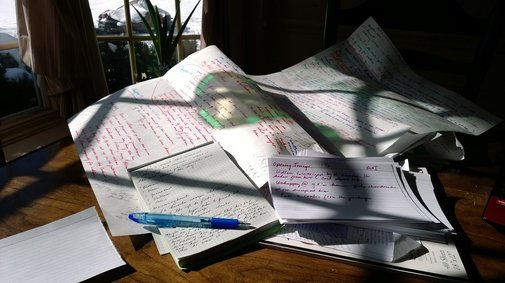I am by nature a dealer in words, and words are the most powerful drug known to humanity.
~ Rudyard Kipling
Editing
Editing is an umbrella term for levels of the work that begins with a wide-angle view of a piece of writing and then progressively narrows that focus to the final close-up. I can help at any level.
Editorial Review. This is a close reading of something you've written, followed by recommendations for next steps. My assessment highlights the work's strengths, what needs more attention, and any other issues that would improve and enhance it.
An editor doesn't just read, he reads well, and reading well is a creative, powerful act. — Susan Bell
Developmental Editing. This is big-picture editing that can happen before writing begins, while writing is in process, and even after the first draft is complete. Developmental editing organizes, structures, and shapes content to convey your message effectively, and big-picture questions guide this prrocess: What do you want to say? Why? Who is your audience? What do you want them to take away from your work?
Structure is not a straitjacket for your words. It is an architect that moves readers through and allows them to pause, not randomly, but with direction. — Susan Bell
Substantive Editing. Like developmental editing, substantive editing also examines a work's structure and may involve reorganization, deletions, or additions. However, the structural work in a substantive edit is less extensive than in a developmental edit, and it happens after the writing has been completed. At this stage, the work of fine-tuning sentences also begins as they are revised and sometimes rewritten for clarity, pace, tone, and style.
Rewriting is a wonderful thing. It's the only department in life where you get to say something and then take it back and figure out how to say it better before anyone has to see it. — Tracy Kidder
Copyediting. Copyediting fine-tunes the details. Not only are grammar, syntax, and punctuation errors corrected, a sentence's design is also evaluated. Word choice, word treatment, and word placement are considered, and consistency of style and tone is established. Fact-checking is another important part of copyediting.
Word choice is more than just a question of precision; the change of word can completely reorient the meaning. The inaccessible word, when suddenly accessed . . . can suggest an entirely new avenue to drive down. — Luc Sante
Proofreading. In this final stage of the editing process (the final close-up), egregious errors in punctuation and grammar that were missed earlier or inadvertently introduced during design are corrected. Formatting and layout are also checked for accuracy and consistency.
Proofread carefully to see if you any words out. — author unknown
Editorial Review. This is a close reading of something you've written, followed by recommendations for next steps. My assessment highlights the work's strengths, what needs more attention, and any other issues that would improve and enhance it.
An editor doesn't just read, he reads well, and reading well is a creative, powerful act. — Susan Bell
Developmental Editing. This is big-picture editing that can happen before writing begins, while writing is in process, and even after the first draft is complete. Developmental editing organizes, structures, and shapes content to convey your message effectively, and big-picture questions guide this prrocess: What do you want to say? Why? Who is your audience? What do you want them to take away from your work?
Structure is not a straitjacket for your words. It is an architect that moves readers through and allows them to pause, not randomly, but with direction. — Susan Bell
Substantive Editing. Like developmental editing, substantive editing also examines a work's structure and may involve reorganization, deletions, or additions. However, the structural work in a substantive edit is less extensive than in a developmental edit, and it happens after the writing has been completed. At this stage, the work of fine-tuning sentences also begins as they are revised and sometimes rewritten for clarity, pace, tone, and style.
Rewriting is a wonderful thing. It's the only department in life where you get to say something and then take it back and figure out how to say it better before anyone has to see it. — Tracy Kidder
Copyediting. Copyediting fine-tunes the details. Not only are grammar, syntax, and punctuation errors corrected, a sentence's design is also evaluated. Word choice, word treatment, and word placement are considered, and consistency of style and tone is established. Fact-checking is another important part of copyediting.
Word choice is more than just a question of precision; the change of word can completely reorient the meaning. The inaccessible word, when suddenly accessed . . . can suggest an entirely new avenue to drive down. — Luc Sante
Proofreading. In this final stage of the editing process (the final close-up), egregious errors in punctuation and grammar that were missed earlier or inadvertently introduced during design are corrected. Formatting and layout are also checked for accuracy and consistency.
Proofread carefully to see if you any words out. — author unknown
Writing
I am a versatile writer with a broad content focus and a portfolio that includes magazine articles, website copy, and even prose poetry.
Coaching and Teaching
Before I transitioned into publishing, I was an English teacher. I love teaching and enjoy this role as a writing coach.
